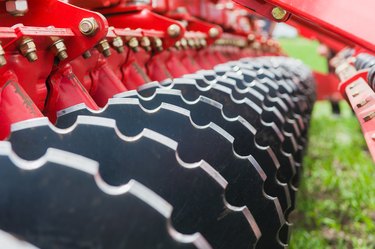
What is the difference between a disc harrow and disc plow? To get the answer, you first need to know what harrows and plows are. Both are farming tools. A harrow has a row of blades attached to a heavy frame that you use to break up large clumps of soil. A plow is more extensive and gets pulled over the soil to turn it over as a first step in preparing the ground.
Types of Disc Harrows
Video of the Day
Harrows can be even more critical than plows for soil preparation, as they are multipurpose tools used for various tasks. They can level out heavy soil, remove dead growth and create fresh seedbeds for root aeration. Plows go down deeper for the initial passes, and harrows fine-tune the soil. Disc harrows have sets of individually mounted, concave discs arranged in opposite directions; this allows them to throw out the soil in more than one way.
Video of the Day
Within this category, there are offset disc harrows that can be attached to tractors. They're best for medium and light soil; they get attached to the back of tractors, and you simply drive in the needed direction. Heavy-duty hydraulic ones have bearing spools that promote better lubrication and less load on the tractor pulling it. They are usually made with durable seals to prevent the bearings and hubs from getting dirty and wet from mud and water. A tandem disc harrow is made with quality steel discs, and they work well for light and medium soil in depths from 100 to 152 millimeters. They are compatible with quick hitches.
Disc Plow vs. Disc Harrow
Disc plows also have discs that are hard, steel and concave, and like disc harrows, the blades can be smooth or serrated. Disc plow blades are generally larger, ranging from 20 to 38 inches, while disc harrow blades measure about 12 to 36 inches in diameter. You'll see disc plows being used to till uncultivated land; farmers use disc harrows after that for the fine-tuning part of the soil preparation process.
To put it another way, harrows are secondary tillage tools used after plows. Disc plows turn over the soil and create wider ridges than disc harrows because the discs are notched, and you can use many more at once. Harrows are brought in to cut the soil to shallow depths for pulverizing and smoothing soil, cutting weeds and mixing materials into the soil. By using these two tools in tandem, the soil is as ready as it can be when it comes to planting season.
More About Disc Harrows
The main parts of the disc harrow include the discs, gang, gang bolt, spool and bearings. The hardened steel discs cut the soil and are mounted onto a common shaft known as the gang. They're connected with the gang bolt and operated with a lever. The spool is a flanked tube mounted on the bolt between every two discs to prevent them from moving.
A disc harrow also has a weight box, a frame that provides extra weight to increase the discs' penetration into the soil. Some disc harrows allow users to add more weight to the frame, but you will need to be sure to follow the manufacturer's specifications for this. They're used with tractors, and new ones can cost between $1,000 and $2,000. You can also find a used disc harrow for sale at outlets that sell farm equipment; these used parts are a more affordable option than brand-new ones.